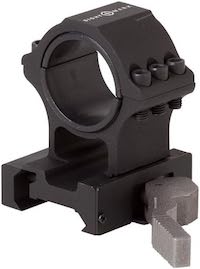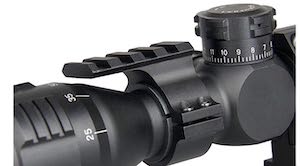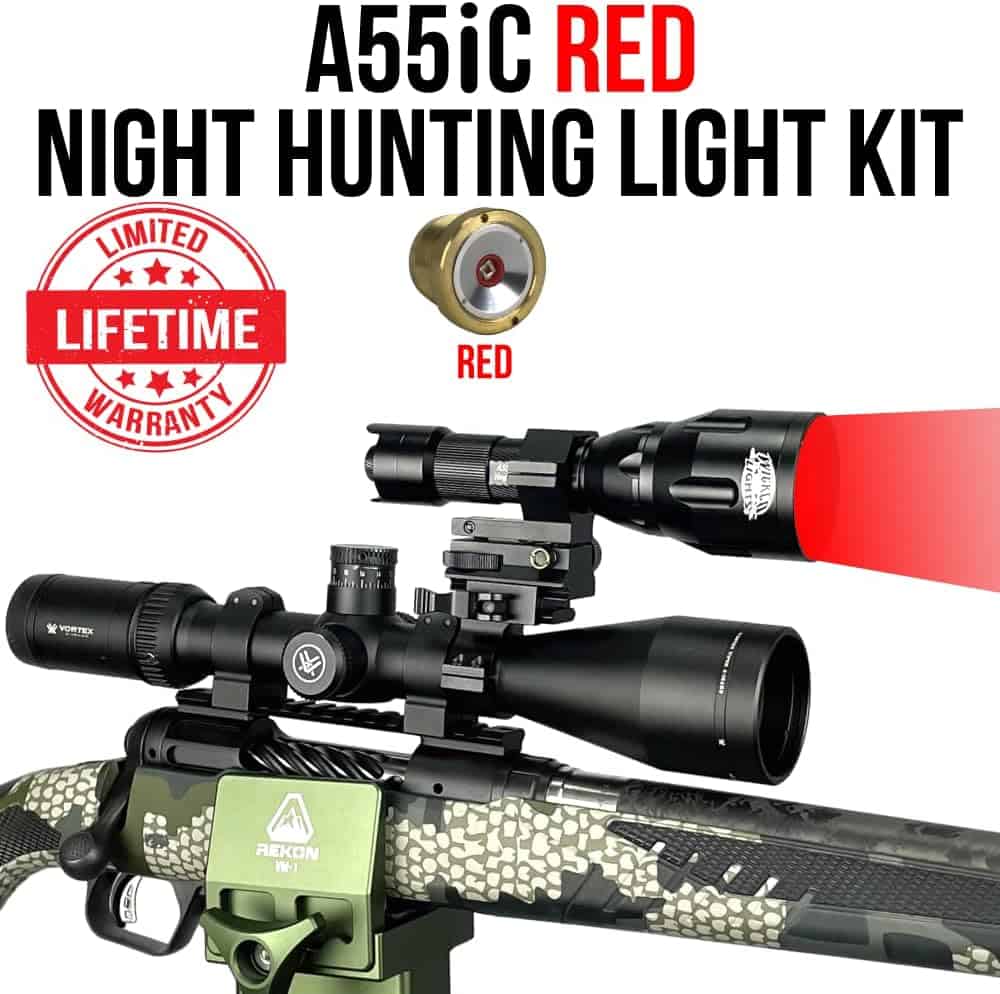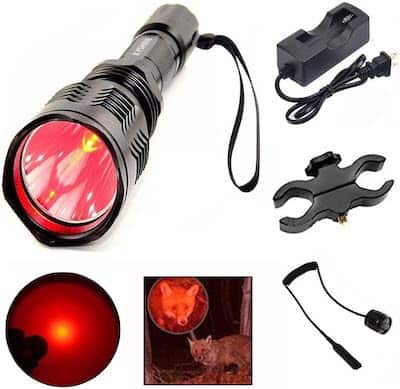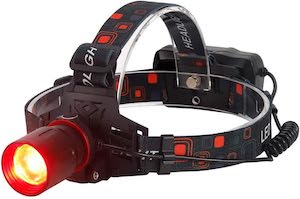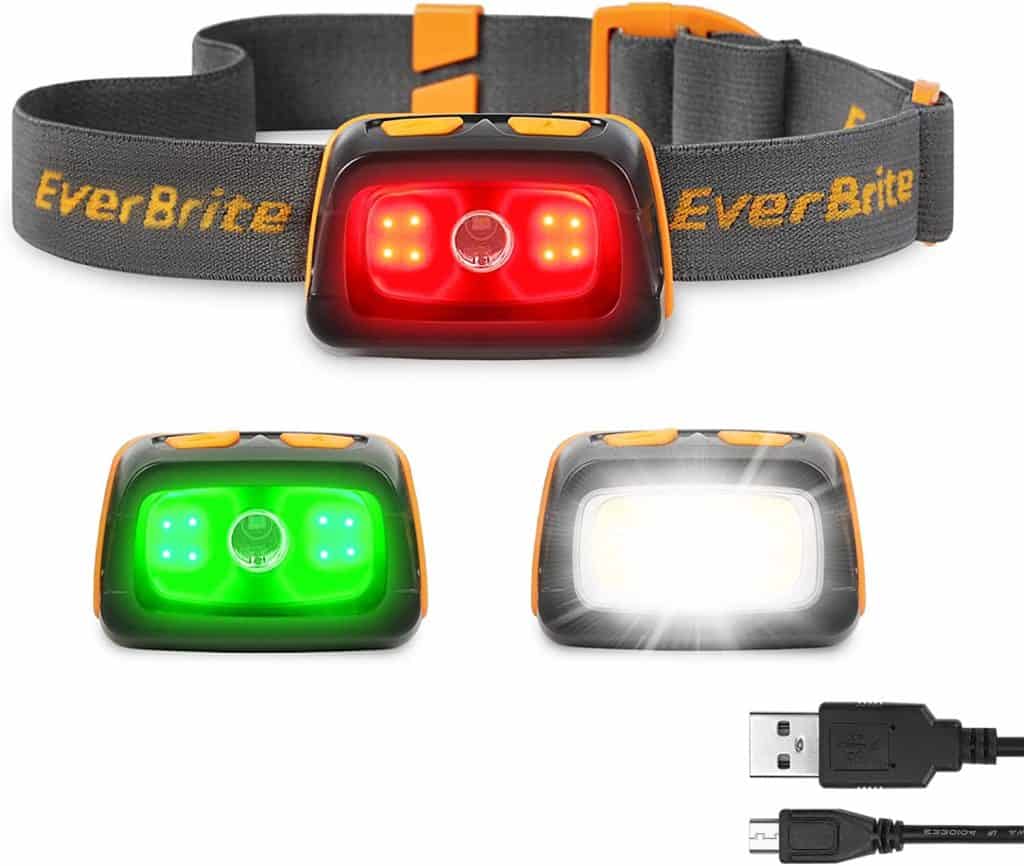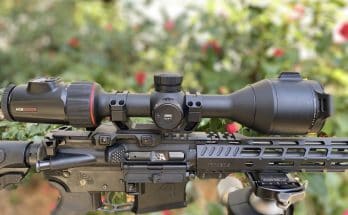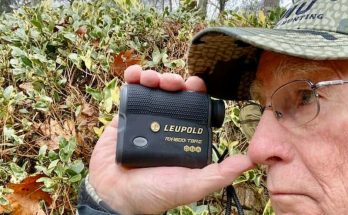The Best Lights For Coyote Hunting At Night – Hunting coyotes at night can be an exhilarating and challenging experience. You do not have to have expensive thermal or night vision scopes to be a successful coyote hunter. People have been using Lights for hunting coyotes at night for years before digital and thermal scopes were available for hunters. I started night hunting with only a headlight when I was just a kid over 50 years ago.
Not only do you have to have the best lights for coyote hunting at night, you must learn know how to use them to successfully take coyotes at night. The Best Lights For Coyote Hunting At Night will make you a better coyote hunter because as coyote hunters know, you spend 95% of your time looking for coyotes, about 4% stalking and less than 1% making the shot. Be prepared for success with the right lights for coyote hunting at night.
To increase your chances of success for taking coyotes at night, incorporating red or green lights into your hunting strategy can make a significant difference. I will give you a few pointers and suggest some of the best red or green lights for coyote hunting at night. I use several of these lights, but I am an Amazon affiliate and may earn a small commission if you purchase a recommended light.
Lights for coyote hunting at night include hand-held flash lights, headlights and weapon mounted lights. In this post we will help you select the lights for hunting coyotes, hogs or predators at night with lights.
Lights For Hunting Coyote Hunting
- The color of the light beam – Red, Green, White or IR
- Battery Type – Must Be 18650
- Weapon Mounted, Hand Held and Headlights
Use 18650 Battery Powered Lights Only

The first thing to understand when buying lights for hunting coyotes at night is about the batteries used to power the light. Choose only lights that are powered by removable, rechargeable 18650 batteries. These powerful hunting lights need a lot of power and lights powered by AA batteries or CR123 batteries are expensive to operate and do not last very long. Do not consider a light that does not use 18650 batteries or lights that must be recharged and do not have removable, quick change 18650 batteries.
See My Blog Post Best 18650 Batteries. Buy 18650 Batteries at AMAZON
Red or Green Beam Lights For Coyote & Hog Hunting At Night

These hunting lights are available with green, red, white and IR light beams. An IR light has an invisible beam and is used in conjunction with night vision scopes. If you are looking for a light to use in conjunction with your daytime scope or a hand held light to scan the area for animals, you will want a green or red beam. Green or red does not spook animals as much as white lights. They do not give away your position as quickly or alarm people who may be within sight of your light.
While you are on stand calling coyotes at night, you will need a light attached to your rifle with green or red beam and a held held or head light with green or red beam to scan the area for incoming coyotes. It is too hard and too much movement to try to scan the area with the light that is mounted to your rifle.
I hunt with my rifle on a tripod so my hands are free to scan and operate an electronic call. Weapon lights need to be purchased with a mount to attach it to your rifle or scope. Most of the weapon lights below are 1″ or 30mm in diameter so they can be mounted with a scope ring that is attached to a picatiny rail on your rifle or a scope ring with a picatiny mount on top like a Burris PEPR mount.
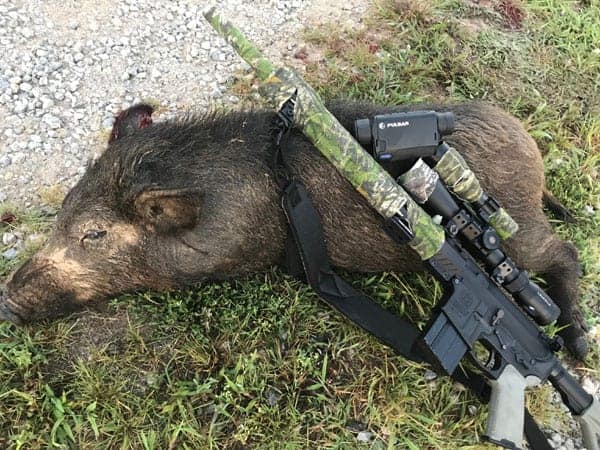
Awesafe Gun Safe, Biometric Gun Safe for Pistols*

Awesafe Single Bedside Gun Safe $65 at AMAZON
Sightmark QD Ring for Lights $27 from AMAZON
The easiest and most secure way I have found to mount a weapons light is a Picatiny scope ring. You just attach the ring to the light and then attach the ring to the Picatiny rail on the rifle or scope ring. In the photo above, my light is attached to the top of my scope ring mount.
I chose a QD mount so I can quickly attach and remove the light to my rifle. You do not need an adjustable mount. If you use the scope ring, it can only point straight down your barrel. Adjustable mounts are more trouble than benefit. I have used both and learned the hard way.
Light Mount Scope Ring only $10 at AMAZON
If you do not have a picatiny rail on your rifle, you can add a light mounting ring onto your scope. It is like a third ring on you scope that you can attach your light using a scope ring.
Best Weapons Lights For Hunting Coyotes At Night
Wicked Lights A55iC Red Night Hunting Light Kit for Coyote and Predators
Shop Wicked Hunting Lights at AMAZON. Several Kits Available
Wicked Hunting Lights has several kits to choose from and they are a top brand in the hunting light industry.
Successfully target hogs, coyotes, fox, bobcat, raccoon and varmints at night with the Wicked Hunting Lights A55iC Ambush Hog & Predator Hunting Night Hunting Light with Intensity Control. The A55iC is purpose designed & built specifically for night hunting. This kit includes everything you need to get out and get hunting:
1 x A55iC Long Range Light with Intensity Control Tail Cap
1 x RED Intensity Control LED
1 x Quick Detach Adjustable Light Mount
1 x 1 inch and 30mm Picatinny Scope Mount
1 x Charger Kit
1 x Carry Case
Hunting Flashlight, HS-802 250 Yards Cree Coyote Hog Red Light Flashlight
HS-802 Hunting Light Kit only $36 At AMAZON
- UltraFire H-R3 red flashlight provides 100% pure red light without any loss due to filtering.
- 630 nm Red Light Flashlight: Equipped with 3 professional XP-E2 blue LEDs that not only illuminate a distance of 256 yards, but also provide 100 degree wide angle illumination.
- Single Mode: Easy to operate, press the switch on the tailcap to turn the flashlight on and off. You don’t need to waste time to change modes.
- Rugged and Durable: Made of aircraft grade aluminum alloy with a matte anodized surface that is scratch, abrasion and corrosion resistant.
- Waterproof and Anti-slip: IPX65 waterproof rating, can work in heavy rain and can withstand bad weather.
Best Handheld Lights For Scanning For Coyotes At Night

In addition to a weapon mounted light, you will also need a handheld light to scan the area for approaching coyotes when calling. These lights can be the same type light as a weapons light. Green or Red beams are best. Be sure to get a light that will focus the beam or open it up for wide area scanning.
As you are calling you need a wide beam to pick up a coyotes eyes as they approach. Coyotes’ eyes reflect the light and you will see shinning eyes before you see the whole coyote. There are a lot of lights available.
You can also get different color LED bulbs to change the color of your light beam instead of buying more lights.
Headlamps for Coyote Hunting
There are two types of headlamps use during coyote hunting. The first is a bright red or green beam scanning light to spot coyotes coming to the call. The second type light is a navigation light with a combination of white and colored lights for navigation. This headlamp should be switchable from white search light to low power short range colored lights for walking to the stand before you call.
XLENTGEN Red Light Hunting Headlamp Rechargeable Red LED Headlamps 3 Modes Super Bright Red Headlamp for Coyote Hunting (Batteries Included)
RED Scanning Headlamp $23 at AMAZON
EverBrite Rechargeable Headlamp – 350 Lumens Headlight with Red/Green Light
3-Color Navigation Utility Headlamp $18 at AMAZON
7 Lighting Modes : The EverBrite headlamp is equipped with a memory mode that stores the brightness setting for the next switch-on. The headlamp features seven different lighting modes. Its dual switches control CREE XPE LED (high/medium/low/strobe) and COB Lighting (White/Red/Green), allowing optimal lighting for any situation. Superior Brightness: With 350 lumens (max setting) of power, the headlamp can easily spot a distance of 196 FT for a maximum of 3 hours, and proximity lighting can emit up to 200 lumens, which gives you a large area of light for any nighttime mission. Ideal for Outdoor Activities: The headlamp is perfect for general use, such as camping, hiking, climbing, fishing, and more. It also has an emergency whistle and a red-flashing taillight on the rear, designed specifically for night runners. Lightweight & Comfortable Headband: The lightweight design (only 3-1/2 oz.) and the adjustable elastic headband will make it comfortable to wear for long periods. 30-Degree tilting head enables you to focus the light wherever you need it.
MOJO Outdoors Critter Predator Hunting Decoy
Lights for Night Vision Scopes
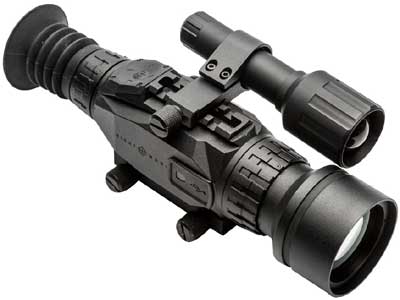
Sightmark Wraith Night Vision Scope with attached IR Light
Night vision scopes rely on a specific type of light called infrared (IR) light. These scopes are designed to capture and amplify existing ambient light, including infrared light, to provide enhanced visibility in low-light or nighttime conditions. While they can operate with any source of ambient light, including moonlight and starlight, many night vision scopes also feature built-in or attachable IR illuminators.
IR illuminators emit infrared light that is not visible to the naked eye but can be detected and amplified by the night vision device. This additional IR light source helps improve visibility in complete darkness or situations where there is little to no natural ambient light available. The emitted IR light reflects off objects in the field of view and is captured by the night vision scope’s sensors, allowing users to see objects and surroundings in the scope’s display.
The use of IR light makes night vision scopes effective for various applications, including wildlife observation, surveillance, law enforcement, and military operations, where the ability to see in low-light or total darkness is crucial. It’s important to note that the strength and range of the IR illuminator can vary between different night vision scopes, so the performance may differ depending on the specific model and purpose.
IR Lights For Night Vision Scopes
Most IR illuminators supplied with night vision scopes are pretty small and will illuminate animals out to about 100-150 yards. Most hunters with a night vision scope prefer larger aftermarket IR lights so they can see out to 500 yards or more with their scope.

My personal choice IR light I use with my night vision scope is the SNIPER HOG Light 66LRX shown in the photo above. I can see hundreds of yards with this light and the size is not overly large. Some coyote hunters who want the most light available choose the Coyote Canon. See specs below.
SNIPER HOG Light 66LRX Light Kit for Night Vision Optics(IR 850nm)

66LRX Light Kit for Night Vision Optics(IR 850nm) $210 at AMAZON
- Adjustable focus so you can go from a flood beam to spot beam
- Interchangeable LED modules so you can easily change the color. IR 850nm is the only color included.
- Will shine 800+ yards with Digital Night vision and 2500+ yards with Gen 3 Night vision
- 2.5 hour run time on 1 3500mA battery
- Can be used as a normal flashlight with the included normal flashlight tail cap.
- Wired Dimmer slide switch that gives the user full control of the lights brightness simply by sliding the switch.
- Physical size : 7″ x 2.75″, 14 oz
Coyote Cannon Kit IR 850nm for Night Vision
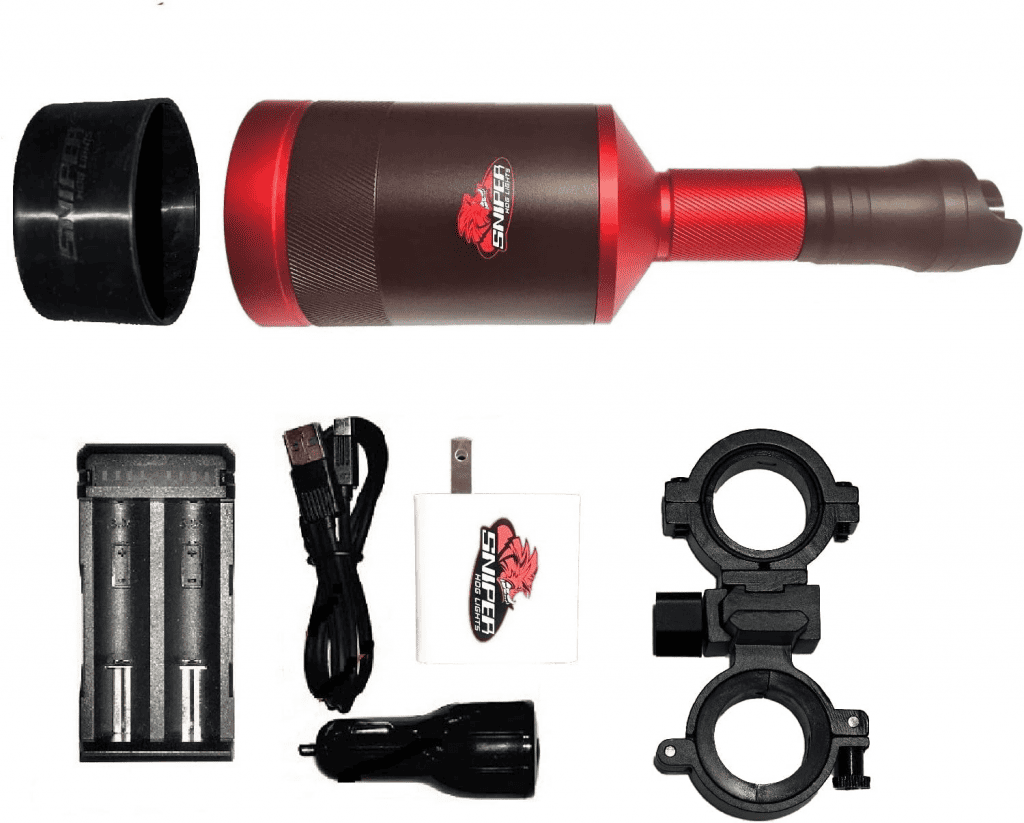
Coyote Cannon Kit IR 850nm for Night Vision $257 at AMAZON
- Furthest Shining IR 850nm LED hunting light on the market
- Focusable from flood to spot beam
- Full dimmer for complete control of the lights brightness
- Included Predator Pro Mount is fully Windage, Elevation and Height adjustable
- Light can be mounted to scopes and weaver/picatinny rails with the Predator Pro Mount
- Included charger will charge from 120V AC, 12V DC or USB outlets
- Physical size: 8.86 x 2.83 x 2.83 inches, 2.1 pounds
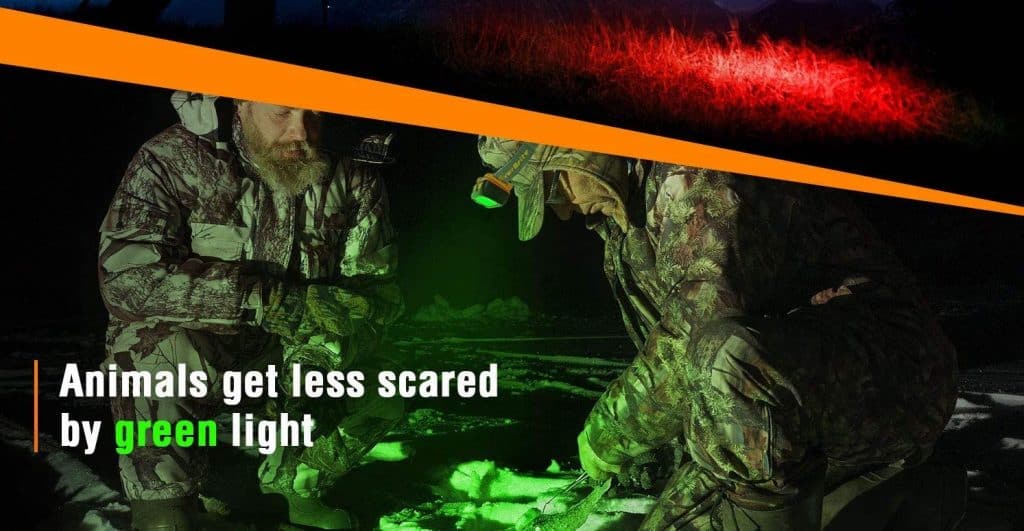
Factors to Consider When Choosing a Coyote Hunting Light
Before diving into the specific recommendations, it’s essential to understand the key factors to consider when selecting a hunting light. These factors include:
- Light Output: Look for lights with high lumens to ensure a bright and focused beam that can reach long distances.
- Beam Distance and Focus: Consider lights with adjustable focus and a long beam distance to spot coyotes even in challenging terrains.
- Battery Life: Opt for lights with 18650 rechargeable batteries to avoid running out of power during hunting sessions.
- Durability: Choose lights that are rugged, weather-resistant, and designed to withstand the demands of outdoor hunting activities.
- Mounting Options: Look for lights that offer versatile mounting options, allowing you to attach them to rifles, shotguns, or other hunting gear.
- Battery: Lights must be powered by 18650 batteries.
Top Coyote / Predator Hunting Lights Recommendations
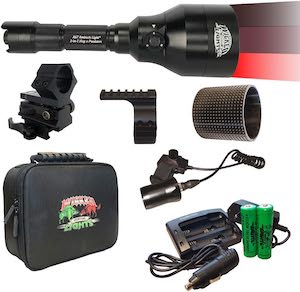
Wicked Lights A67iC Predator Light: Designed specifically for predator hunting, this light offers a versatile beam focus, interchangeable LED modules, and a remote control for convenient operation.
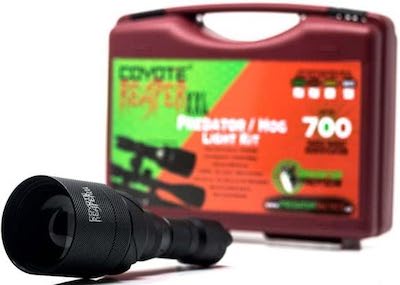
Predator Tactics Coyote Reaper XXL: With its adjustable focus and 1,000-lumen output, this light is built for long-range illumination, making it an excellent choice for coyote hunters.
Choosing a Coyote Hunting Light
Illuminating the Night: How to Use Red or Green Lights for Coyote / Predator Hunting
Red and green lights have distinct advantages when it comes to coyote Lights For Night Hunting. Both colors offer improved visibility without spooking coyotes, as these animals are less sensitive to red and green light spectrum. The benefits of using red or green lights include:
- Reduced Spooking: Coyotes are less likely to be alarmed by red or green light, allowing you to observe them without causing unnecessary disturbance.
- Enhanced Visibility: Red or green lights can improve your visibility in low-light conditions, helping you spot coyotes and effectively aim your shots.
- Preserving Night Vision: Red or green lights are less likely to disrupt your night vision compared to white lights, enabling you to maintain your visual acuity during the hunt.
Using Red or Green Lights for Coyote Hunting
Choose the Right Light: Select a hunting light specifically designed for coyote hunting, preferably one that offers adjustable brightness levels and beam focus. Ensure the light is durable, weather-resistant, and can be easily mounted on your firearm or other hunting gear.
Understand Your Target: Familiarize yourself with the behavior and habits of coyotes. This knowledge will help you determine the optimal time and areas to use your light effectively.
Select the Appropriate Color: Decide whether to use red or green light based on the terrain, vegetation, and the specific hunting conditions you’ll encounter. Green lights tend to penetrate dense foliage better, while red lights can be more effective in open areas.
Preserve Stealth: When approaching your hunting spot, avoid using lights unnecessarily to maintain a stealthy approach. Coyotes have keen senses, and excessive light can alert them to your presence.
Scanning and Spotting: Once you’re in position, use your red or green light to scan the surroundings carefully. Sweep the area in a methodical manner, focusing on areas where coyotes are likely to appear, such as open fields, brushy edges, or near water sources.
Illuminating the Target: When you spot a coyote, illuminate it briefly with your light to identify its location and assess the shot opportunity. Be mindful not to continuously shine the light on the animal, as this can startle or alert them.
Taking the Shot: Once you’ve spotted a likely target with your scanning light, identify your target with your weapon mounted light to make sure it is a coyote or other predator, and not the neighbors dog. Take the shot only when you have 100% positive ID of your animal.
Safety Considerations
Prioritize safety during your coyote hunting endeavors. Ensure that you are familiar with local hunting regulations and follow firearm safety protocols. Be aware of your surroundings and the presence of other hunters. Additionally, when using lights, be considerate of neighboring properties and avoid shining lights into residential areas.
Conclusion
Using red or green lights for coyote hunting at night can provide you with a tactical advantage while minimizing the risk of spooking your targets. By selecting the appropriate light, understanding coyote behavior, and employing proper scanning and spotting techniques, you can enhance your hunting success in low-light conditions. Remember to prioritize safety and adhere to local hunting regulations. Good luck!
Why Hunters Go After Elusive Coyotes in the Dark
Coyote hunting, the most often hunted predator, has long been a popular pastime for many outdoor enthusiasts and hunters across North America. While many hunters hunt coyotes during the day, an increasing number of them are turning to nighttime hunting as an effective strategy. But why do hunters choose to venture into the darkness to pursue these cunning creatures? Let’s delve into the reasons behind the practice of hunting coyotes at night.
1. Coyotes are Nocturnal Predators
Coyotes are highly adaptable creatures known for their intelligence and elusive behavior. They are primarily nocturnal animals, meaning they are most active during the night and early morning hours. By hunting coyotes at night, hunters align their efforts with the natural behavior of these animals, increasing the likelihood of encountering them while they are on the prowl for food.
2. Enhanced Stealth and Concealment
The cover of darkness provides a significant advantage for hunters. Reduced visibility makes it more challenging for coyotes to detect human presence, allowing hunters to call or approach their prey more closely without being noticed. This stealthiness is crucial for a successful hunt, as coyotes are notoriously cautious and quick to flee if they sense danger.
3. Artificial Light Sources
Nighttime coyote hunting typically involves the use of artificial light sources, such as spotlights, night vision goggles, or thermal imaging devices. These tools provide hunters with the ability to see in the dark, effectively turning night into day. Spotlights can illuminate the eyes of coyotes, making them easier to spot, while thermal equipment can reveal their heat signatures. These technologies significantly improve a hunter’s ability to locate and target coyotes in the dark.
4. Pest Control and Conservation
In most regions, coyotes are considered pests due to their impact on livestock and small game populations. Hunting them at night can be a more effective method for managing their numbers. Coyote populations can grow rapidly, and nighttime hunting helps prevent overpopulation while minimizing disturbances to other wildlife.
5. Safety and Comfort
Nighttime hunting can offer safety benefits in areas where daytime temperatures can be extreme, such as deserts or hot climates. By hunting in cooler nighttime conditions, hunters can avoid the risks of heat-related illnesses. Additionally, nighttime hunting can reduce the chances of accidentally disturbing other outdoor activities or recreational enthusiasts who are active during the day.
It’s important to note that the practice of hunting coyotes at night is subject to legal regulations and restrictions that vary by location. Many states and regions require special permits or licenses for nighttime predator hunting. Ethical and responsible hunting practices should always be followed, including adherence to local hunting laws and guidelines, safety precautions, and respect for the animals being hunted.
In conclusion, hunting coyotes at night is a strategic approach that aligns with the natural behavior of these elusive predators. By embracing the cover of darkness and utilizing advanced technologies, hunters increase their chances of success while contributing to pest control efforts and conservation. When done responsibly and within the confines of the law, nighttime coyote hunting can be a rewarding and challenging pursuit for outdoor enthusiasts.
Coyotes Hunting To Protect Calves and Fawns
Coyote hunting is about the only method of controlling the spread of coyotes and their numbers far exceed the number taken by hunters. Trapping coyotes does not work well at all as they are usually too smart to be taken with traps. Science has shown that coyotes take a heavy toll on whitetail fawns.
At least one study found that coyotes can eat as many as 75 percent of the fawns born in a single spring and deer populations are declining in some parts of the country, possibly as a result of an increase in coyote numbers.
Coyotes have spread to 49 states in the USA and are presently the most abundant livestock predators in North America, causing the majority of sheep, goat, and cattle losses. Hundreds of thousands of sheep, cattle, and goats fall victim to predators each year. In fact, predators cause some of the most significant losses to the sheep industry nationwide.
Livestock losses attributed to predators cost U.S. ranchers and producers more than $71 million annually, according to statistics compiled by the U.S. Department of Agriculture’s (USDA) NationalAgricultural Statistics Service (NASS).
The coyote (Canis latrans) is a species of canine native to North America. It is smaller than its close relative, the wolf, and slightly smaller than the closely related eastern wolf and red wolf. It fills much of the same ecological niche as the golden jackal does in Eurasia. The coyote is larger and more predatory and was once referred to as the American jackal by a behavioral ecologist. Other historical names for the species include the prairie wolf and the brush wolf.


